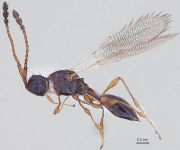 Fig 1. Female, profile |
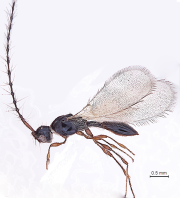 Fig 2. Male, profile |
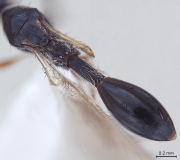 Fig 3. Body, dorsal view |
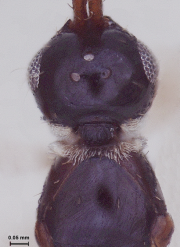 Fig 4. Head, dorsal view |
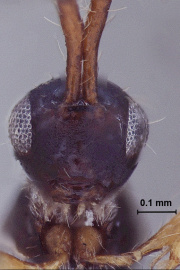 Fig 5. Head, front view |
|
 Fig 6. Antenna (female) |
 Fig 7. Antenna (male) |
 Fig 8. Forewing |
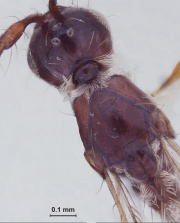 Fig 9. Mesosoma |
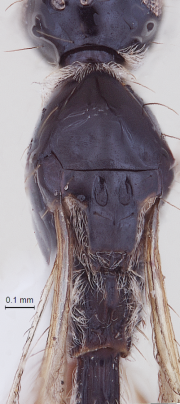 Fig 10. Mesosoma |
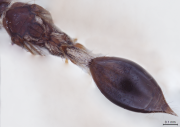 Fig 11. Metasoma (female) |
 Fig 12. Petiole and metasoma |
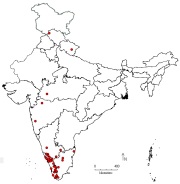 Fig 13.
Distribution map |
|
Nomenclature
Trichopria Ashmead, 1893: 407, 431. Type species : Trichopria pentaplasta Ashmead.
Ashmeadopria Kieffer, 1912: 8, 10, 59. Synonymized by Muesebeck and Walkley, 1951: 1420 pp.
Phaenopria Ashmead, 1893: 40, 436. Synonymized by Sundholm, 1960: 215-223.
Planopria Kieffer, 1906: 19. Synonymized by Kieffer, 1912: 75 pp.
Orthopria Kieffer, 1911: 983, 984. Synonymized by Kieffer, 1912: 75 pp.
Diagnosis
1.5-3mm long, delicate to robust forms. Head and body yellowish/reddish brown to black, with appendages usually lighter in colour, body smooth and shining, lacking micropilosity, with sparse long semierect hairs, hairy cushion often well developed on post gena, sides of pronotum and upper part of propleuron, foamy structures sometimes indicated, particularly on axillar regions and petiole.
Head often globose. Antennal shelf well developed in lateral view. Antennae 12-segmented in females, 14-segmented in males, in both sexes antennal segments variable in shape, but mostly with long tubular base and a swollen distal part ciliate, with long hairs, much longer than width of A2, either arranged in whorls or irregularly scattered. Female antennae with non-abrupt clava, number of claval segments variable 3-6. Male antennae filiform, segment 3 subequal to 4, A4 usually modified, slightly emarginate and carinate. Vertex unarmed, eye size variable. Mandibles normal, bidentate, never developed into a beak. Malar sulcus rarely developed. Occipital flange distinct, but not step-like.
Cervix distinct. Pronotal shoulders less angular and more curved. Mesoscutum without notauli and humeral sulcus. Anterior scutellar pit without foveae, or mono or bifoveate. Scutellar sheath at times medially with a carina or rarely spined. Lateral and posterior scutellar pits absent, sternaulus not indicated. Dorsellum with three keels medially, propodeum sometimes elongate, with variable pilosity dorsally and laterally, with median keel anteriorly produced into a blunt tooth, with a dorsal semi hyaline zone. Area between lateral carinae (plicae) and median carina bare. Nucha indicated in some cases.
Wings usually well developed; venation extending only to one-third of forewing length; in forewings, submarginal vein moderately close to wing margin. Costal cell extremely narrow, marginal vein short. Postmarginal absent, stigmal vein very much reduced. Basal vein usually absent, but at times nebulous and arcuate. Marginal cilia well developed, length nearly one-fifth of forewing width. Submarginal vein on hindwings complete.
Petiole usually longer than wide, and with longitudinal striae, often hidden by tufts of hairs. Anterior margin f T2/large tergite at an elevated level of petiole and without a median furrow or emargination. Metasoma elongate oval, basal tergites telescoped under large tergite, visible as narrow rings only.
Geographic Distribution
See Fig. 13 for distribution of the genus in India.
Species known from India
1. Trichopria arca Rajmohana & Narendran
2. Trichopria atturensis Sharma
3. Trichopria clavata Rajmohana & Narendran
4. Trichopria contigua Sharma
5. Trichopria cristata Rajmohana & Narendran
6. Trichopria disulcata Rajmohana & Narendran
7. Trichopria fringa Rajmohana & Narendran
8. Trichopria gautami Rajmohana & Narendran
9. Trichopria gopii Rajmohana & Narendran
10. Trichopria indica (Kieffer)
11. Trichopria khandala Sharma
12. Trichopria krishagathra Rajmohana & Narendran
13. Trichopria lacustris Sharma
14. Trichopria malabarensis Rajmohana & Narendran
15. Trichopria minuta Rajmohana & Narendran
16. Trichopria montana Sharma
17. Trichopria pedicellata Sharma
18. Trichopria petiolata Rajmohana & Narendran
19. Trichopria rufa (Kieffer)
20. Trichopria semicirculara Rajmohana & Narendran
21. Trichopria spinosa Rajmohana & Narendran
22. Trichopria syrphidarum (Kieffer)
23. Trichopria tetraclavata Rajmohana & Narendran
24. Trichopria tibia Rajmohana & Narendran
25. Trichopria triclavata Rajmohana & Narendran
Remarks
Most common in collections. A highly widespread and diverse group, members show great variation in size, colour, distribution pattern of hairs and nature of antennal segments. Normal mandibles, antenna 12-segmented in female and 14-segmented in male, clava non-abrupt in females, notauli absent and forewings without a tubular basal vein, serve to separate this genus from other diapriines.
References
Ashmead, W. H. 1893. Monograph of the North American Proctotrypidae. United States National Museum Bulletin 45: 1-472.
Kieffer, J. J. 1906. Description de quelques nouveaux serphides. Bulletin de la Société d'Histoire Naturelle de Metz, 25: 1-7.
Kieffer, J. J. 1911. Species des Hyménoptères d'Europe et d'Algérie. Vol. 10. Pages 753-912. Librarie Scientifique A. Hermann & Fils, Paris. Pp.
Kieffer, J. J. 1912. Fam. Diapriidae. Genera Insectorum. No. 124. 75 pp.
Muesebeck C. F. W and Walkley, L.M. 1951. Superfamily Proctotrupoidea. Pages 655-718 in Muesebeck, Krombein & Townes. Hymenoptera of America north of Mexico -- Synoptic Catalog. U.S. Dept. Agriculture Monograph No. 2. 1420 pp.
Rajmohana, K and Bijoy, C., 2012. A checklist of Diapriidae and Proctotrupidae (Hymenoptera: Insecta) from India.
Sundholm, A. 1960. On Diapria Latreille and allied genera (Hym., Diapriidae). Opuscula Entomologica, 25: 215-223.
|